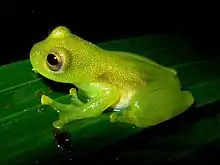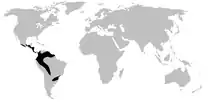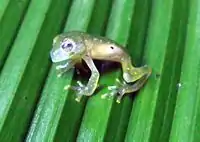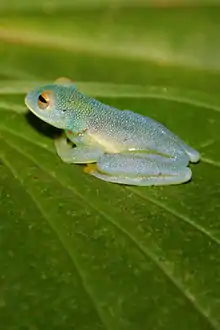Glass frog
The glass frogs are frogs of the amphibian family Centrolenidae (order Anura). While the general background coloration of most glass frogs is primarily lime green, the abdominal skin of some members of this family is transparent and translucent. The internal viscera, including the heart, liver, and gastrointestinal tract, are visible through the skin, hence the common name is given as glass frog. Glass frogs are arboreal, meaning they mainly live in trees, and only come out for mating season.
| Glass frog | |
|---|---|
 | |
| Hyalinobatrachium ruedai | |
| Scientific classification | |
| Kingdom: | Animalia |
| Phylum: | Chordata |
| Class: | Amphibia |
| Order: | Anura |
| Suborder: | Neobatrachia |
| Clade: | Hyloidea |
| Family: | Centrolenidae Taylor, 1951 |
| Subfamilies | |
 | |
| Distribution of Centrolenidae (in black) | |
Taxonomy
The first described species of Centrolenidae was the "giant" Centrolene geckoideum, named by Marcos Jiménez de la Espada in 1872, based on a specimen collected in northeastern Ecuador. Several species were described in subsequent years by different herpetologists (including G. A. Boulenger, G. K. Noble, and E. H. Taylor), but usually placed together with the tree frogs in the genera Hylella or Hyla.
The family Centrolenidae was proposed by Edward H. Taylor in 1945. Between the 1950s and 1970s, most species of glass frogs were known from Central America, particularly from Costa Rica and Panama, where Taylor, Julia F., and Jay M. Savage extensively worked, and just a few species were known to occur in South America. In 1973, John D. Lynch and William E. Duellman published a large revision of the glass frogs from Ecuador, showing the species richness of Centrolenidae was particularly concentrated in the Andes. Later contributions by authors such as Juan Rivero, Savage, William Duellman, John D. Lynch, Pedro Ruiz-Carranza, and José Ayarzagüena increased the number of described taxa, especially from Central America, Venezuela, Colombia, Ecuador, and Peru.
The evolutionary relationships, biogeography, and character evolution of centrolenids were discussed by Guayasamin et al. (2008[1]) Glass frogs originated in South America and dispersed multiple times into Central America. Character evolution seems to be complex, with multiple gains and/or losses of humeral spines, reduced hand webbing, and complete ventral transparency.
The taxonomical classification of the glass frogs has been problematic. In 1991, after a major revision of the species and taxonomic characters, the herpetologists Pedro Ruiz-Carranza and John D. Lynch published a proposal for a taxonomic classification of the Centrolenidae based on cladistic principles and defining monophyletic groups.[2] That paper was the first of a series of contributions dealing with the glass frogs from Colombia that led them to describe almost 50 species of glass frogs. The genus Centrolene was proposed to include the species with a humeral spine in adult males, and the genus Hyalinobatrachium to include the species with a bulbous liver.[2] However, they left a heterogeneous group of species in the genus Cochranella, defined just by lacking a humeral spine and a bulbous liver.[2] Since the publication of the extensive revision of the Colombian glass frogs, several other publications have dealt with the glass frogs from Venezuela, Costa Rica, and Ecuador.
In 2006, the genus Nymphargus was erected[3] for the species with basal webbing among outer fingers (part of the previous Cochranella ocellata species group).
Four genera (Centrolene, Cochranella, Hyalinobatrachium, Nymphargus) have been shown to be poly- or paraphyletic[1] and recently a new taxonomy has been proposed (see below).
Classification
The family Centrolenidae is a clade of anurans. Previously, the family was considered closely related to the family Hylidae; however, recent phylogenetic studies[4] have placed them (and their sister taxon, the family Allophrynidae) closer to the family Leptodactylidae.
The monophyly of Centrolenidae is supported by morphological and behavioral characters, including:1) presence of a dilated process on the medial side of the third metacarpal (an apparently unique synapomorphy); 2) ventral origin of the musculus flexor teres digiti III relative to the musculus transversi metacarpi I; 3) terminal phalanges T-shaped; 4) exotroph, lotic, burrower/fossorial tadpoles with a vermiform body and dorsal C-shaped eyes, that live buried within leaf packs in still or flowing water systems; and 5) eggs clutches deposited outside of water on vegetation or rocks above still or flowing water systems. Several molecular synapomorphies also support the monophyly of the clade.[4]
The taxonomic classification of the Centrolenidae was recently modified. The family now contains two subfamilies and 12 genera.[5]
Genera
- Subfamily Centroleninae
- Genus Centrolene Jiménez de la Espada, 1872
- Genus Chimerella Guayasamin, Castroviejo, Trueb, Ayarzagüena, Rada, Vilá, 2009
- Genus Cochranella Taylor, 1951
- Genus Espadarana Guayasamin, Castroviejo, Trueb, Ayarzagüena, Rada, Vilá, 2009
- Genus Nymphargus Cisneros-Heredia & McDiarmid, 2007
- Genus Rulyrana Guayasamin, Castroviejo, Trueb, Ayarzagüena, Rada, Vilá, 2009
- Genus Sachatamia Guayasamin, Castroviejo, Trueb, Ayarzagüena, Rada, Vilá, 2009
- Genus Teratohyla Taylor, 1951
- Genus Vitreorana Guayasamin, Castroviejo, Trueb, Ayarzagüena, Rada, Vilá, 2009
- Genus incertae sedis
- "Centrolene" acanthidiocephalum (Ruiz-Carranza and Lynch, 1989)
- "Centrolene" azulae (Flores and McDiarmid, 1989)
- "Centrolene" guanacarum Ruiz-Carranza and Lynch, 1995
- "Centrolene" medemi (Cochran and Goin, 1970)
- "Centrolene" petrophilum Ruiz-Carranza and Lynch, 1991
- "Centrolene" quindianum Ruiz-Carranza and Lynch, 1995
- "Centrolene" robledoi Ruiz-Carranza and Lynch, 1995
- "Cochranella" duidaeana (Ayarzagüena, 1992)
- "Cochranella" euhystrix (Cadle and McDiarmid, 1990)
- "Cochranella" geijskesi (Goin, 1966)
- "Cochranella" megista (Rivero, 1985)
- "Cochranella" ramirezi Ruiz-Carranza and Lynch, 1991
- "Cochranella" riveroi (Ayarzagüena, 1992)
- "Cochranella" xanthocheridia Ruiz-Carranza and Lynch, 1995
- Subfamily Hyalinobatrachinae
- Genus Celsiella Guayasamin, Castroviejo, Trueb, Ayarzagüena, Rada, Vilá, 2009
- Genus Hyalinobatrachium Ruiz-Carranza & Lynch, 1991 – "True" Glass Frogs
- Subfamily incertae sedis
- Ikakogi Guayasamin, Castroviejo, Trueb, Ayarzagüena, Rada, Vilá, 2009
 Cochranella albomaculata from Costa Rica
Cochranella albomaculata from Costa Rica Cochranella granulosa from Costa Rica
Cochranella granulosa from Costa Rica
Characteristics
Glass frogs are generally small, ranging from 3 - 7.5cm (1.2 - 3.0) in length. They are green in color over most of their bodies, except for the skin along the lower surface of the body and legs, which are transparent [6] or translucent.[7]
Glass frogs are similar in appearance to some green frogs of the genus Eleutherodactylus and to some tree frogs of the family Hylidae. However, hylid tree frogs have eyes that face to the side, whilst those of glass frogs face forward. Some species of green tree frogs (especially juveniles), such as Hyloscirtus palmeri and Hypsiboas pellucens, have the transparent abdominal skin typical of glass frogs, but they also have calcars on the heels, a character not present in any species of the Centrolenidae.
Two members of the glass-frog family Centrolenidae (Centrolenella fleischmanni, C. prosoblepon) and the hylid subfamily Phyllomedusinae (Agalychnis moreletii, Pachymedusa dacnicolor) reflect near-infrared light (700 to 900 nanometers) when examined by infrared color photography. Infrared reflectance may confer adaptive advantage to these arboreal frogs both in thermoregulation and infrared cryptic coloration.[8]
Camouflage
The evolutionary advantage of a partly clear skin, but with opaque back, was a mystery, as it did not seem to be effective as camouflage. It was found that the colour of the frog's body changed little against darker or lighter foliage, but the legs were more translucent and consequently changed in brightness. By resting with the translucent legs surrounding the body, the frog's edge appears softer, with less brightness gradient from the leaf to the legs and from the legs to the body, making the outline less noticeable. Experiments with computer-generated images and gelatine models of opaque and translucent frogs found that the translucent frogs were less visible, and were attacked by birds significantly less often.[7]
Distribution
The Centrolenidae are a diverse family, distributed from southern Mexico to Panama, and through the Andes from Venezuela and the island of Tobago to Bolivia, with some species in the Amazon and Orinoco River basins, the Guiana Shield region, southeastern Brazil, and northern Argentina.
Biology
Glass frogs are mostly arboreal. They live along rivers and streams during the breeding season, and are particularly diverse in montane cloud forests of Central and South America, although some species occur also in Amazon and Chocóan rainforest and semideciduous forests.
Hyalinobatrachium valerioi glass frogs are carnivores, their diet mainly including small insects like crickets, moths, flies, spiders, and other smaller frogs.[9]
The eggs are usually deposited on the leaves of trees or shrubs hanging over the running water of mountain streams, creeks, and small rivers. One species leaves its eggs over stones close to waterfalls. The method of egg-laying on the leaf varies between species. The males usually call from leaves close to their egg clutches. These eggs are less vulnerable to predators than those laid within water, but are affected by the parasitic maggots of some fly species.[6] As a result, some glass frogs show parental care. In many species, glass frog females brood their eggs during the night the eggs are fertilized, which improves the survival of the eggs, while in almost a third of species, glass frog males stay on guard for much longer periods. After they hatch, the tadpoles fall into the waters below.[10] The tadpoles are elongated, with powerful tails and low fins, suited for fast-flowing water.[6] Outside of the breeding season, some species live in the canopy.
References
- Guayasamin, J. M.; Castroviejo-Fisher, S.; Ayarzaguena, J.; Trueb, L.; Vilá, C. (2008). "Phylogenetic relationships of glass frogs (Centrolenidae) based on mitochondrial and nuclear genes". Molecular Phylogenetics and Evolution. 48 (2): 574–595. doi:10.1016/j.ympev.2008.04.012.
- Ruíz-Carranza, P.M. and J. D. Lynch. 1991. Ranas Centrolenidae de Colombia I: propuesta de una nueva clasificación genérica. Lozania, 57, 1–30.
- Cisneros-Heredia, D.F. & McDiarmid, R.W. (2006). A new species of the genus Centrolene (Amphibia: Anura: Centrolenidae) from Ecuador with comments on the taxonomy and biogeography of Glassfrogs. Archived 2011-07-21 at the Wayback Machine Zootaxa 1244: 1–32 – Description of Centrolene mariaelenae. (PDF of the abstract available by clicking here)
- Frost, D. R.; Grant, T.; Faivovich, J. N.; Bain, R. H.; Haas, A.; Haddad, C. L. F. B.; De Sá, R. O.; Channing, A.; Wilkinson, M.; Donnellan, S. C.; Raxworthy, C. J.; Campbell, J. A.; Blotto, B. L.; Moler, P.; Drewes, R. C.; Nussbaum, R. A.; Lynch, J. D.; Green, D. M.; Wheeler, W. C. (2006). "The amphibian tree of life". Bulletin of the American Museum of Natural History. 297: 1–291. doi:10.1206/0003-0090(2006)297[0001:TATOL]2.0.CO;2. hdl:2246/5781.
- Guayasamin, J. M.; Castroviejo-Fisher, S.; Trueb, L.; Ayarzagüena, J.; Rada, M.; Vilà, C. (2009). "Phylogenetic systematics of glassfrogs (Amphibia: Centrolenidae) and their sister taxon Allophryne ruthveni". Zootaxa. 2100: 1–97. doi:10.11646/zootaxa.2100.1.1. hdl:1808/13694.
- Zweifel, Robert G. (1998). Cogger, H.G.; Zweifel, R.G. (eds.). Encyclopedia of Reptiles and Amphibians. San Diego: Academic Press. pp. 94–95. ISBN 0-12-178560-2.
- Nicola Davis (25 May 2020). "Why glass frogs have see-through skin becomes clear in study". The Guardian.
- Schwalm, P.; Starrett, P.; McDiarmid, R. (1977). "Infrared reflectance in leaf-sitting neotropical frogs". Science. 196 (4295): 1225–1227. doi:10.1126/science.860137. PMID 860137.
- "Reticulated Glass Frog Hyalinobatrachium valerioi". henryvilaszoo.gov. Henry Vilas Zoo, Madison, WI. Archived from the original on 11 April 2020. Retrieved 30 August 2020.
- "(Some) Frogs Are Better Parents Than We Thought | Research". www.bu.edu. Retrieved 2017-04-04.
- Kubicki, Brian. Ranas De Vidrio – Costa Rica – Glass Frogs (2007). In Spanish and English. ISBN 9968-927-25-2.
External links
| Wikimedia Commons has media related to Centrolenidae. |
| Wikispecies has information related to Centrolenidae. |
| Look up glass frog in Wiktionary, the free dictionary. |
- Amphibian Species of the World
- Centrolenidae in AmphibiaWeb Ecuador
- Centrolenidae in AmphibiaWeb
- Glassfrogs (Centrolenidae) Project
- Centrolenidae in the Tree of Life site
- Centrolenidae in ITIS
- Research on Centrolenidae
- Centrolenidae in Livingunderworld.org
- Centrolenidae in Animal Diversity Web
- Centrolenidae en InfoNatura
- Fleischmann’s glass frog at National Geographic
- Various Frog Species